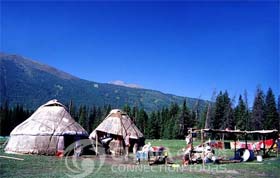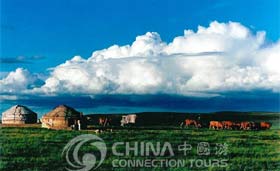 Xilamuren Tourist Spot, which is situated in the northern place of Hohhot, 80 km away from the urban area. Xilamuren, meaning "yellow river" in Mongolian, is located 100 kilometers north of Hohhot. It is cool even in hot summer. There are 62 Mongolian yurts, among which 30 Mongolian yurts are standard.
Xilamuren Tourist Spot, which is situated in the northern place of Hohhot, 80 km away from the urban area. Xilamuren, meaning "yellow river" in Mongolian, is located 100 kilometers north of Hohhot. It is cool even in hot summer. There are 62 Mongolian yurts, among which 30 Mongolian yurts are standard.
Xilamuren Prairie, a typical example on the plateau, is covered by green grass and fresh flowers every summer and autumn. Due to the continual investment of the local government, reception service is growing better and better. Thus, Xilamuren has become a popular scenic spot in Inner Mongolia. The main reason for most visitors to Inner Mongolia is for a grasslands experience, and Hohhot is well set up to accommodate this with its copious tourist facilities. Travelers may be a little put off by modern facilities, Han Chinese run resorts, and the crowds that often come in summer. However, if you have not experienced the grasslands before, fun can still easily be had, even on the tours, by trekking off on your own into the rolling grasses for scenery that is pretty and remote.
And also, Xilamuren Prairie is commonly known as Taihe, got its name for Puhui Temple, a Lama temple built in the Qing dynasty near Xilamuren River. Constructed in 1769 during the reign of Emperor Qianlong, Puhui Temple was initially a resort of the Sixth Panchen Lama of Xilitu of Hohhot. With engraved beams and pictured tiles, the temple appears quite splendid. With more than sixty yurts, the scenic spot is full of ethnic folk life. The Xilamuren River is flowing behind the Pu'Hui temple.
 Although it is possible to visit one of the grassland areas in one day, it is far nicer to spend a night or two out here in a Mongolian traditional tent (yurt). These yurts are made of compressed sheep wool and are shaped rather like a squat native American teepee, windowless, sheep-smelling and snug. The yurts are made from latticed wood frames, have thick, rug floors and are usually furnished with many blankets, low beds, quilts, pillows and hot water flasks. They were originally designed to be folded up and carried by camel, however nowadays most of them are slightly more solidly built on concrete yards, in yurt type camps that have numerous yurts and usually a dining area, a washroom with occasional hot water and even electric light.
Although it is possible to visit one of the grassland areas in one day, it is far nicer to spend a night or two out here in a Mongolian traditional tent (yurt). These yurts are made of compressed sheep wool and are shaped rather like a squat native American teepee, windowless, sheep-smelling and snug. The yurts are made from latticed wood frames, have thick, rug floors and are usually furnished with many blankets, low beds, quilts, pillows and hot water flasks. They were originally designed to be folded up and carried by camel, however nowadays most of them are slightly more solidly built on concrete yards, in yurt type camps that have numerous yurts and usually a dining area, a washroom with occasional hot water and even electric light.
Entertainments in these areas are many. You may try activities such as Mongolian wrestling, horse & camel riding, rodeo competitions, archery, visiting traditional families, and trips to the aobaos (rock mounds that are normally festooned with flags, meant for worship). The best time to do all this is during Naadam Festival, in the second half of August, when the crowds are out in full and a fair-like atmosphere is created. In the evenings the camps provide interesting, if sometimes a little taxing, activities, including a baijiu dinner and performances of traditional dancing, singing and melodies from traditional Mongolian instruments, including the sawing charms of the horsehead fiddle (Matou qin). Some of the sites have halls for disco, but this is probably best missed out.

